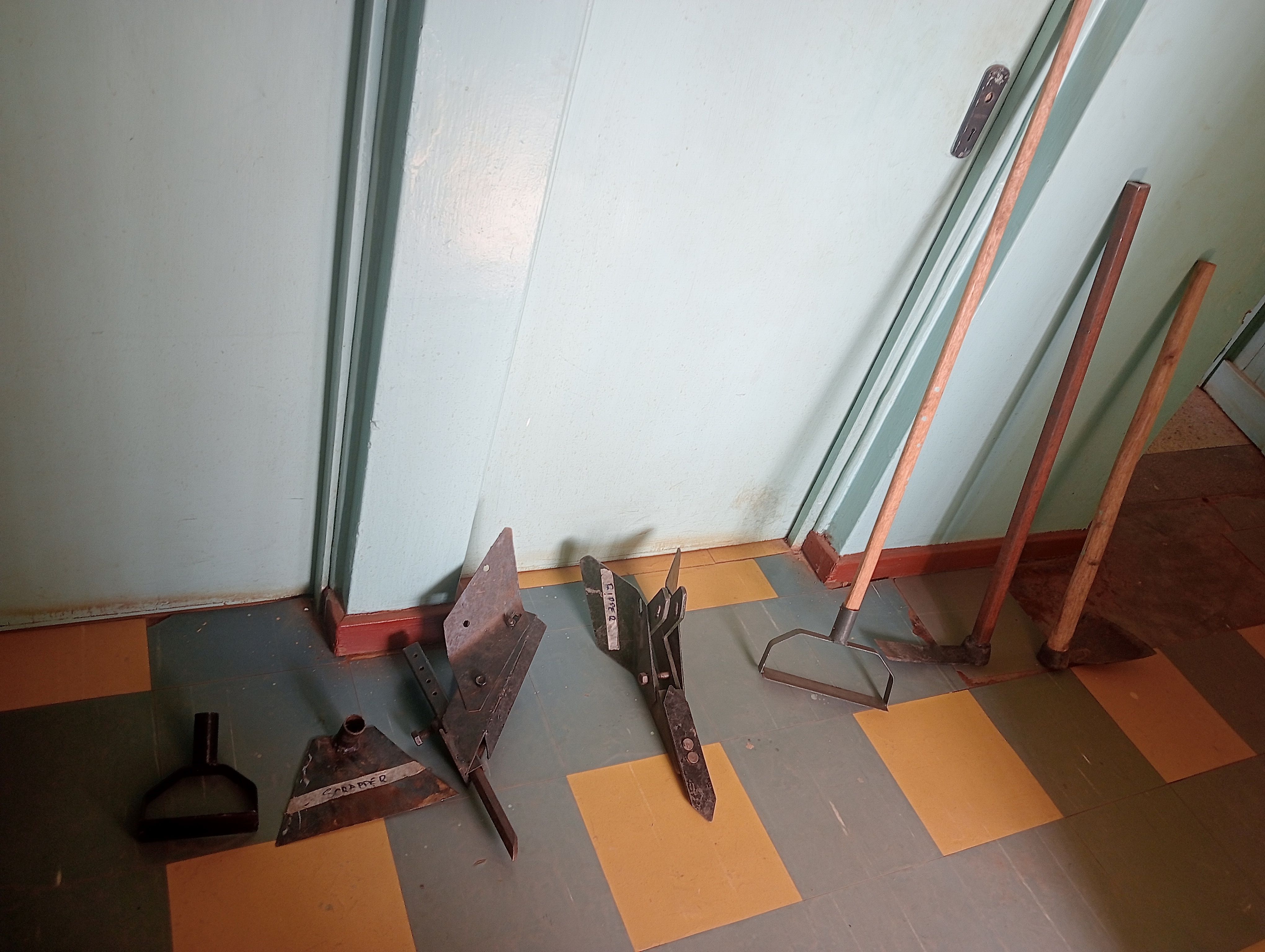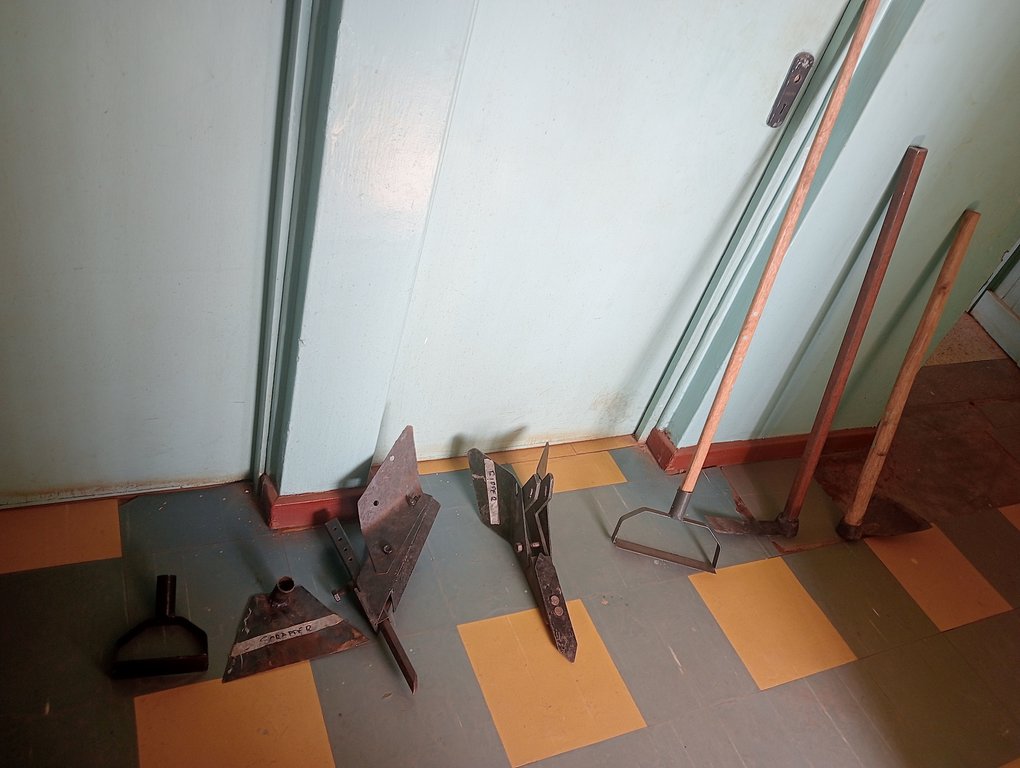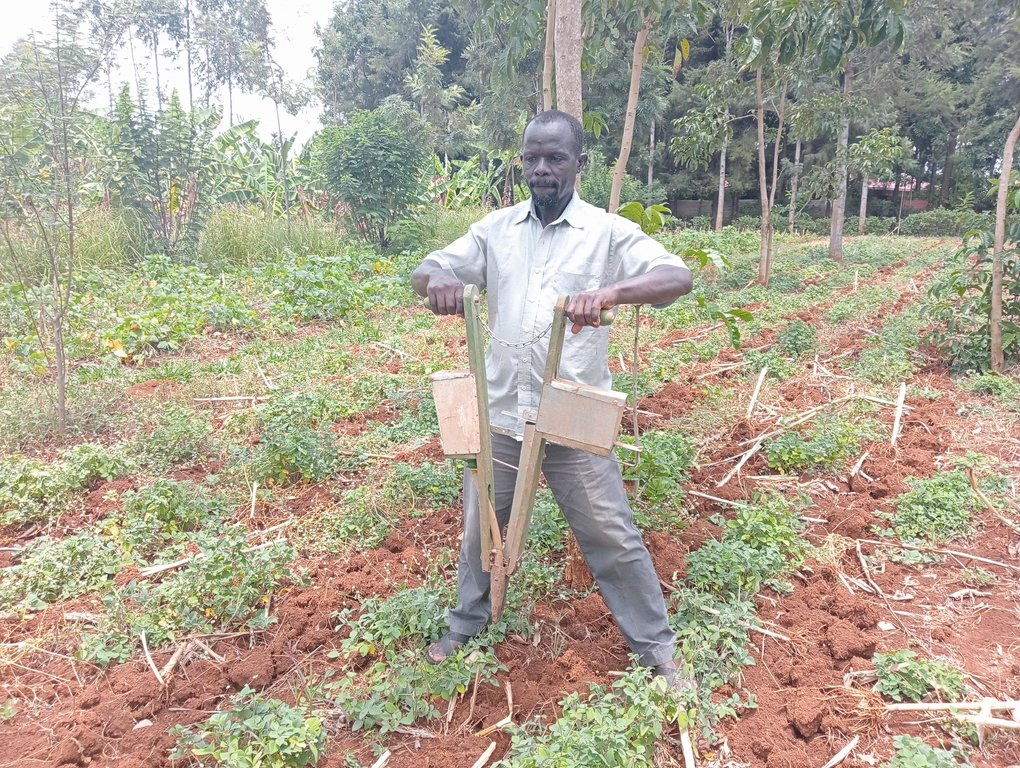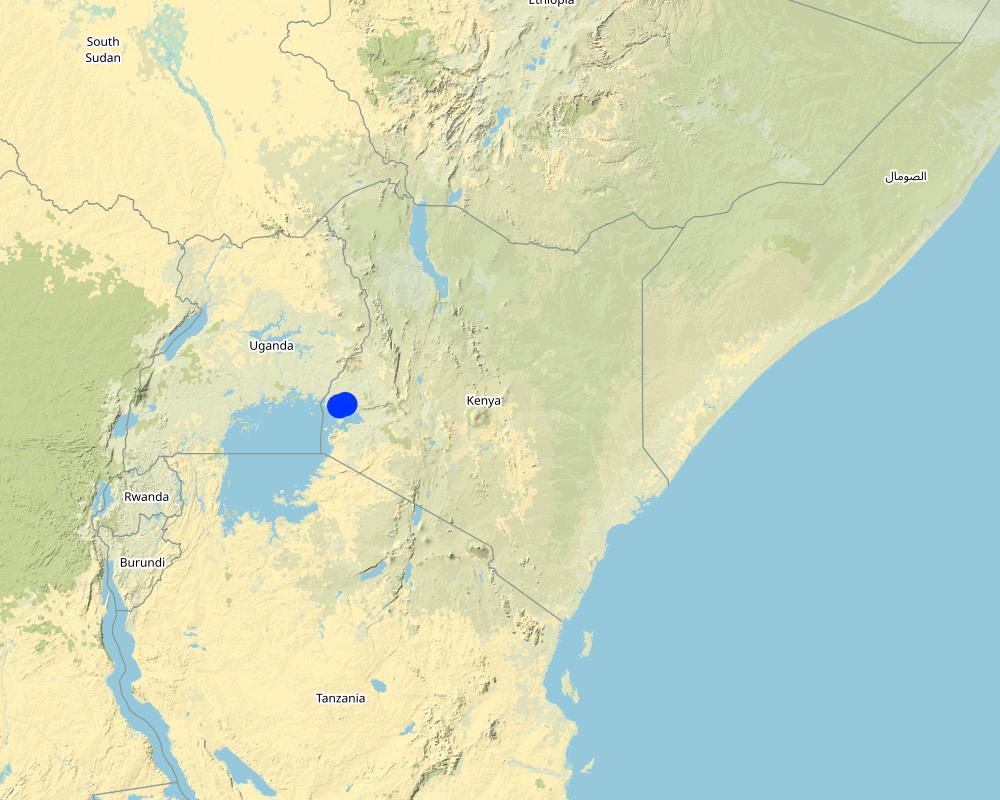Improving farmers' access to tools for conservation agriculture [เคนยา]
- ผู้สร้างสรรค์:
- การอัพเดท:
- ผู้รวบรวม: William Akwanyi
- ผู้เรียบเรียง: Christopher Nyakan, Christopher Nyakan, Innocent Faith, Noel Templer
- ผู้ตรวจสอบ: William Critchley, Rima Mekdaschi Studer
Kuendeleza kilimo hifadhi
approaches_6738 - เคนยา
ดูส่วนย่อย
ขยายทั้งหมด ย่อทั้งหมด1. ข้อมูลทั่วไป
1.2 รายละเอียดที่ติดต่อได้ของผู้รวบรวมและองค์กรที่เกี่ยวข้องในการประเมินและการจัดเตรียมทำเอกสารของแนวทาง
วิทยากรหลัก
ผู้ใช้ที่ดิน:
Ong'anda William Ouma
+254 722 236015 / +254 733 529508
GFA farmer
William Ong'anda's farm in Umoyo Village, Gem North Ward, Gem Yala Sub-county, in Siaya County
เคนยา
ผู้เชี่ยวชาญ SLM:
Opiyo Elizaphat
+254 718 288816
opiyoelizaphat@gmail.com
Rural Energy and Food Security Organization (REFSO)
เคนยา
ผู้เชี่ยวชาญ SLM:
Khasakhala Eboche Dave
+254 721 569842
khasakhalaedo@yahoo.com
Agricultural Technology Development Centre (ATDC), Siaya
Agricultural Technology Development Centre (ATDC), Siaya
เคนยา
ผู้เชี่ยวชาญ SLM:
ผู้เชี่ยวชาญ SLM:
ชื่อของโครงการซึ่งอำนวยความสะดวกในการทำเอกสารหรือการประเมินแนวทาง (ถ้าเกี่ยวข้อง)
Soil protection and rehabilitation for food security (ProSo(i)l)ชื่อของโครงการซึ่งอำนวยความสะดวกในการทำเอกสารหรือการประเมินแนวทาง (ถ้าเกี่ยวข้อง)
Deutsche Gesellschaft für Internationale Zusammenarbeit (GIZ)ชื่อของโครงการซึ่งอำนวยความสะดวกในการทำเอกสารหรือการประเมินแนวทาง (ถ้าเกี่ยวข้อง)
Alliance Bioversity and International Center for Tropical Agriculture (Alliance Bioversity-CIAT) - เคนยา1.3 เงื่อนไขที่เกี่ยวข้องกับการใช้ข้อมูลที่ได้บันทึกไว้ผ่านทาง WOCAT
วันที่เก็บรวบรวมข้อมูล (ภาคสนาม):
11/03/2023
ผู้รวบรวมและวิทยากรหลักยอมรับเงื่อนไขเกี่ยวกับการใช้ข้อมูลที่ถูกบันทึกผ่านทาง WOCAT:
ใช่
1.4 การอ้างอิงถึงแบบสอบถามเรื่องเทคโนโลยี SLM
2. คำอธิบายของแนวทาง SLM
2.1 การอธิบายแบบสั้น ๆ ของแนวทาง
Improving farmers' access to minimum tillage tools is an approach to increasing the adoption of conservation agriculture (CA) through linking them to institutions that fabricate the tools.
2.2 การอธิบายอย่างละเอียดของแนวทาง
การอธิบายอย่างละเอียดของแนวทาง:
Using minimum tillage tools in land preparation, planting, and weed management helps to achieve the principle of minimal soil disturbance in conservation agriculture (CA). However, one of the main challenges facing the adoption of minimum tillage is the high cost of minimum tillage tools. In this approach, the ProSoil project sought to overcome the challenges of accessibility to and high cost of minimum tillage tools. GIZ through Gesellschaft für Agrarprojekte in Übersee (GFA) collaborated with the County Departments of Agriculture’s Agricultural Technology Development Centers (ATDCs) to train local artisans (welders) on how to fabricate minimum tillage tools at reduced cost and ensure easy access. Currently, the farmers can order hand-held minimum tillage tools such as jab planters, hand-held scrapers, shallow weeders, hand-held subsoilers, animal draft power (ADP) subsoilers, ADP rippers, and chaka hoes from ATDCs and local fabricators at reduced costs. In addition, farmers with large pieces of land can hire heavy minimum tillage implements from ATDCs at affordable rents. The project has also partnered with the Kenya Agricultural and Livestock Research Organization (KALRO) to ensure continuous research on the minimum tillage tools and how to improve them based on the different farm settings.
To increase knowledge about minimum tillage, GFA facilitated local community-based organizations to train farmers on the importance of minimum tillage and how to use minimum tillage tools. In Gem Yala area of Siaya County, Kenya, GFA partnered with Rural Energy and Food Security Organization (REFSO) to offer these pieces of training to the farmers through their groups and link them to local manufacturers. Each group consisted of about 25 farmers of which at least 30% were women. The trainings take place at designated venues in localities that are easily accessible by farmers from different locations.
Farmers like this approach because they have been linked to the manufacturers of the tools and have had their capacity built on how to use the tools. They are therefore able to access the tools easily and at affordable prices. They are also motivated to adopt minimum tillage after having benchmarked in other farms are seen how minimum tillage has improved production.
2.3 รูปภาพของแนวทาง
2.4 วีดีโอของแนวทาง
ความคิดเห็น อธิบายสั้นๆ:
A farmer demonstrating how to use a chaka hoe
https://www.youtube.com/watch?v=LMgULi30Jso&ab_channel=WilliamOnura
วันที่:
11/03/2023
สถานที่:
William Ong'anda's farm in Umoyo Village, Gem North Ward, Gem Yala Sub-county, in Siaya County
ชื่อของผู้ถ่ายวีดีโอ:
William Onura
ความคิดเห็น อธิบายสั้นๆ:
A farmer demonstrating how to use a jab planter
https://www.youtube.com/watch?v=1bxoc5IL_pM&ab_channel=WilliamOnura
วันที่:
11/03/2023
สถานที่:
William Ong'anda's farm in Umoyo Village, Gem North Ward, Gem Yala Sub-county, in Siaya County
ชื่อของผู้ถ่ายวีดีโอ:
William Onura
ความคิดเห็น อธิบายสั้นๆ:
A farmer demonstrating how to use a shallow weeder
https://www.youtube.com/watch?v=HMFrEybintM&ab_channel=WilliamOnura
วันที่:
11/03/2023
สถานที่:
William Ong'anda's farm in Umoyo Village, Gem North Ward, Gem Yala Sub-county, in Siaya County
ชื่อของผู้ถ่ายวีดีโอ:
William Onura
2.5 ประเทศ ภูมิภาค หรือสถานที่ตั้งที่ได้นำแนวทางไปใช้
ประเทศ:
เคนยา
ภูมิภาค/รัฐ/จังหวัด: :
Siaya County, Nyanza Region
ข้อมูลเฉพาะเพิ่มเติมของสถานที่ตั้ง:
Gem North Ward in Gem Yala Sub-county
Map
×2.6 วันที่เริ่มต้นและสิ้นสุดของแนวทาง
ระบุปีที่เริ่ม:
2020
ความคิดเห็น:
The approach is still in use.
2.7 ประเภทของแนวทาง
- ใช้โครงงานหรือแผนงานเป็นฐาน
2.8 เป้าหมายหรือวัตถุประสงค์หลักของแนวทาง
Aim: To increase the adoption of conservation agriculture (CA).
Objective: To improve farmers' access to minimum tillage tools.
2.9 เงื่อนไขที่เอื้ออำนวยหรือเป็นอุปสรรคต่อการนำเทคโนโลยีภายใต้แนวทางนี้ไปปฏิบัติใช้
บรรทัดฐานและค่านิยมทางสังคม วัฒนธรรม ศาสนา
- เอื้ออำนวย
Most farmers have accepted the technology.
การมีไว้ให้หรือการเข้าถึงแหล่งการเงินและบริการ
- เอื้ออำนวย
Less capital investments in maintaining the technologies under the approach.
การร่วมมือหรือการทำงานประสานกันของผู้ลงมือปฏิบัติ
- เอื้ออำนวย
Collaboration with Kenya Agricultural, Livestock Research Organisation (KALRO) and Agricultural Technology and Development Centres (ATDC), local artisans, farmer groups, and Rural Energy and Food Security Organization (REFSO) in tool production and training.
ความรู้เกี่ยวกับ SLM การเข้าถึงการสนับสนุนด้านเทคนิค
- เอื้ออำนวย
Working together with partners from the county department of agriculture to increase awareness about the tools.
- เป็นอุปสรรค
Not preferred by farmer who want to have benefits in the short term.
ปริมาณงานที่ทำได้ กำลังคนที่มีให้
- เอื้ออำนวย
Reduced workload in the long run.
3. การมีส่วนร่วมและบทบาทของผู้มีส่วนได้ส่วนเสียที่เกี่ยวข้อง
3.1 ผู้มีส่วนได้ส่วนเสียที่เกี่ยวข้องในแนวทางนี้และบทบาท
- ผู้ใช้ที่ดินระดับท้องถิ่นหรือชุมชนระดับท้องถิ่น
Farmers - men, women, and youth.
Targeted by the technologies and implement them.
- องค์กรที่ขึ้นอยู่กับชุมชน
Umoya Farmers Self-Help Group
Convening farmers during trainings.
- ผู้เชี่ยวชาญ SLM หรือที่ปรึกษาการเกษตร
SLM specialists from the ProSoil project, Rural Energy and Food Security Organization (REFSO) and the Agricultural Technology Development Centre (ATDC).
Technical support and advisories to farmers i.e., pass the SLM knowledge to the community resource persons in the community.
- นักวิจัย
Kenya Agricultural and Livestock Research Organization (KALRO)
Continuous research on the CA tools and how to improve them based on the different settings.
- ภาคเอกชน
Rural Energy and Food Security Organization (REFSO)
Worked hand-in-hand with other SLM specialists to pass the SLM knowledge to the farmers.
- รัฐบาลระดับท้องถิ่น
Agricultural extension officers from the county government department of agriculture i.e., the Agricultural Technology Development Centre (ATDC).
Worked hand-in-hand with other SLM specialists to pass the SLM knowledge to the farmers.
- องค์การระหว่างประเทศ
GIZ
Proposal design and financial support to the implementation of the approach.
ถ้ามีผู้มีส่วนได้ส่วนเสียหลายคนที่เกี่ยวข้องให้ระบุหน่วยงานตัวแทน:
GIZ
3.2 การเกี่ยวข้องของผู้ใช้ที่ดินระดับท้องถิ่นหรือชุมชนระดับท้องถิ่นในช่วงต่างๆของแนวทาง
| ความเกี่ยวข้องของผู้ใช้ที่ดินระดับท้องถิ่นหรือชุมชนระดับท้องถิ่น | ระบุผู้ที่มีส่วนเกี่ยวข้องและอธิบายกิจกรรม | |
|---|---|---|
| การริเริ่มหรือการจูงใจ | ไม่ลงมือ | Farmers in the community, targeted by the SLM technologies under the approach and awareness on access to the minimum tillage tools. |
| การวางแผน | ปฏิสัมพันธ์ | Agricultural Technology Development Centre (ATDC) and Rural Energy and Food Security Organization (REFSO) jointly agree with farmers on when to engage each other, especially time and venue for training and awareness creation on access to tools. |
| การดำเนินการ | ระดมกำลังด้วยตนเอง | Once trained, farmers implement the SLM technologies on their own, but may seek further advice from the SLM specialists where necessary. |
| การติดตามตรวจสอบหรือการประเมินผล | ไม่ลงมือ | The planning for and conduct of monitoring and/ or evaluation is a role of GIZ and WHH. Farmers are mainly interviewed based on pre-determined questions. |
| Research | ปฏิสัมพันธ์ | Continued research by ATDC and KALRO in consultation with farmers to develop tools that are suitable for different settings/ farmlands. |
3.3 แผนผังแสดงขั้นตอนการทำงาน (ถ้ามี)
คำอธิบาย:
The ProSoil (GIZ and WHH) provides financial support for research by the Kenya Agricultural and Livestock Researchj Organization (KALRO) and for training of farmers by Rural Energy and Food Security Organization (REFSO) and of local artisans by the Agricultural Technology Development Centre (ATDC). Umoya Farmers Self-Help Group convenes farmers for training.
ผู้เขียน:
William Akwanyi
3.4 การตัดสินใจเลือกใช้เทคโนโลยี SLM
ระบุผู้ที่ทำการตัดสินใจเลือกเทคโนโลยีมากกว่าหนึ่งวิธีไปปฏิบัติใช้:
- ผู้ลงมือปฏิบัติที่เกี่ยวข้องทั้งหมดในฐานะที่เป็นส่วนรวมของแนวทาง
การอธิบาย:
Decisions on what SLM technologies to implement were made mainly by most partners i.e., GIZ, GFA, KALRO, ATDC, REFSO, and the farmers.
ระบุว่าการตัดสินใจตั้งอยู่บนพื้นฐานของ:
- การประเมินความรู้ SLM ที่ได้ทำการบันทึกไว้เป็นอย่างดี (การใช้ข้อมูลในการตัดสินใจ)
- สิ่งที่ค้นพบจากงานวิจัย
4. การสนับสนุนด้านเทคนิค การสร้างขีดความสามารถ และการจัดการด้านความรู้
4.1 การสร้างขีดความสามารถ / การอบรม
ได้มีการจัดอบรมให้แก่ผู้ใช้ที่ดินหรือผู้มีส่วนได้ส่วนเสียคนอื่น ๆ หรือไม่:
ใช่
ให้ระบุว่าใครเป็นผู้ได้รับการอบรม:
- ผู้ใช้ที่ดิน
- เจ้าหน้าที่ภาคสนาม / ที่ปรึกษา
- Local artisans
ถ้าเกี่ยวข้อง ให้ระบุ เพศ อายุ สถานภาพ ชาติพันธุ์ เป็นต้น:
Farmers in their groups (Umoya Farmers Self-Help Group), about 25 farmers in a group, and at least 30% of the number were women.
รูปแบบการอบรม:
- กำลังดำเนินการ
- เกษตรกรกับเกษตรกร
- ใช้พื้นที่ทำการสาธิต
หัวข้อที่พูด:
1. Benefits of conservation agriculture - minimum tillage
2. Different types of minimum tillage tools
3. How to use different minimum tillage tools
4. Linkage to minimum tillage tools fabricators
4.2 การบริการให้คำแนะนำ
ผู้ใช้ที่ดินมีการเข้าถึงการรับบริการให้คำปรึกษาหรือไม่:
ใช่
ระบุว่ามีบริการให้คำปรึกษาหรือไม่:
- ไปเยี่ยมชมสถานที่
- ที่ศูนย์ถาวร
การอธิบาย/แสดงความคิดเห็น:
SLM specialists advise farmers at their farms whenever they visit them. Farmers can also visit ATDC, KALRO, and REFSO offices for advice. Farmers are also trained at designated venues in groups.
4.3 การเสริมความแข็งแกร่งให้กับสถาบัน (การพัฒนาองค์กร)
สถาบันได้รับการจัดตั้งขึ้นมาหรือเสริมความแข็งแกร่งโดยแนวทางนี้หรือไม่:
- ใช่ ปานกลาง
ระบุระดับของสถาบันที่ได้รับการเสริมความแข็งแกร่งหรือจัดตั้งขึ้นมา:
- ท้องถิ่น
อธิบายถึงสถาบัน บทบาทและความรับผิดชอบ สมาชิก เป็นต้น:
About 10 REFSO SLM specialists have been capacity built/ trained.
ระบุประเภทของการให้ความช่วยเหลือสนับสนุน:
- การสร้างขีดความสามารถ / การอบรม
ให้รายละเอียดเพิ่มเติม :
Training on CA, its benefits, and how and where to access CA tools.
4.4 การติดตามตรวจสอบและประเมินผล
การติดตามตรวจสอบและประเมินผลเป็นส่วนหนึ่งของแนวทางหรือไม่:
ใช่
ความคิดเห็น:
GIZ and GFA regularly follows up with local artisans and the Agricultural Technology Development Centre (ATDC) to check on the number of farmers who have bought/ access minimum tillage tools.
ถ้าตอบว่าใช่ แสดงว่าการจัดเตรียมเอกสารนี้มุ่งหวังที่จะเอาไปใช้สำหรับการติดตามตรวจสอบและประเมินผลใช่หรือไม่:
ไม่ใช่
ความคิดเห็น:
This documentation in intended for keeping a record of SLM technologies and approaches.
4.5 การวิจัย
การวิจัยเป็นส่วนหนึ่งของแนวทางหรือไม่:
ใช่
- Tool suitability
ให้ข้อมูลเพิ่มเติมและให้ระบุผู้ทำการวิจัย:
Research was done by the Agricultural Technology Development Centre (ATDC) and the Kenya Agricultural and Livestock Research Organization (KALRO) to determine which minimum tillage tools are suitable for which farm settings.
5. การสนับสนุนด้านการเงินและวัสดุอุปกรณ์
5.1 ระบุงบประมาณประจำปีสำหรับแนวทาง SLM นี้
ถ้าหากว่างบประมาณประจำปีไม่เป็นที่ทราบแน่นอน ให้ระบุช่วงลงไป:
- 10,000-100,000
แสดงความคิดเห็น (แหล่งของการระดมทุน ผู้บริจาคคนสำคัญ):
Training costs met by GIZ ProSoil project. The cost covers training of a group of about 25 farmers and a group of about 20 local fabricators, and research in tool suitability.
5.2 การสนับสนุนด้านการเงิน / วัสดุอุปกรณ์ให้แก่ผู้ใช้ที่ดิน
ผู้ใช้ที่ดินได้รับการสนับสนุนด้านการเงิน / วัสดุอุปกรณ์ไปปฏิบัติใช้เทคโนโลยีหรือไม่:
ใช่
ถ้าใช่ ให้ระบุประเภทของการสนับสนุน เงื่อนไขและผู้จัดหามาให้:
GIZ through GFA supported farmers in their groups with minimum tillage tools for demonstration purposes.
5.3 เงินสนับสนุนสำหรับปัจจัยนำเข้า (รวมถึงแรงงาน)
- อุปกรณ์
| ระบุปัจจัยนำเข้าที่ได้รับการสนับสนุน | เห็นด้วยระดับไหน | ระบุเงินสนับสนุน |
|---|---|---|
| เครื่องมือ | ได้รับการช่วยเหลือทางการเงินแบบเต็ม | GIZ through GFA supported farmers in their groups with CA tools for demonstration purposes. |
ถ้าแรงงานโดยผู้ใช้ที่ดินเป็นปัจจัยนำเข้าที่มีอยู่มากมาย ระบุด้วยว่าเนื่องจาก:
- สมัครใจ
ความคิดเห็น:
Farmers provided labour at demonstration plots.
5.4 เครดิต
มีการจัดหาเครดิตมาให้ภายใต้แนวทาง SLM หรือไม่:
ไม่ใช่
5.5 แรงจูงใจหรือเครื่องมืออื่น ๆ
แรงจูงใจหรือเครื่องมืออื่น ๆ ได้ถูกนำไปใช้ส่งเสริมการใช้เทคโนโลยี SLM หรือไม่:
ไม่ใช่
6. การวิเคราะห์ผลกระทบและการสรุป
6.1 ผลกระทบของแนวทาง
ทำให้ผู้ใช้ที่ดินระดับท้องถิ่นมีอำนาจขึ้น ปรับปรุงการเข้าร่วมของผู้มีส่วนได้ส่วนเสียให้ดีขึ้นหรือไม่:
- ไม่ใช่
- ใช่ เล็กน้อย
- ใช่ ปานกลาง
- ใช่ อย่างมาก
Farmers have been empowered with skills on how to use minimum tillage tools and where and how to access them.
ช่วยในการตัดสินใจโดยดูจากหลักฐาน ได้หรือไม่:
- ไม่ใช่
- ใช่ เล็กน้อย
- ใช่ ปานกลาง
- ใช่ อย่างมาก
Demonstration/ learning plots were important in enabling farmers to learn from the practitioners and from each other based on evidence.
ช่วยให้ผู้ใช้ที่ดินนำเอาเทคโนโลยี SLMไปใช้และบำรุงรักษาสภาพไว้ได้หรือไม่:
- ไม่ใช่
- ใช่ เล็กน้อย
- ใช่ ปานกลาง
- ใช่ อย่างมาก
Farmer were trained on minimum tillage.
ปรับปรุงความร่วมมือกันและการดำเนิน งานของ SLM ได้อย่างมีประสิทธิผลหรือไม่:
- ไม่ใช่
- ใช่ เล็กน้อย
- ใช่ ปานกลาง
- ใช่ อย่างมาก
The Agriculture Technology Development Centre (ATDC) trained local artisans on how to fabricate minimum tillage tools and sells them to farmers at a lower price than that in the other farmers' shops.
ปรับปรุงความรู้และความสามารถของผู้ใช้ที่ดินในการดำเนินการ SLM หรือไม่:
- ไม่ใช่
- ใช่ เล็กน้อย
- ใช่ ปานกลาง
- ใช่ อย่างมาก
Farmer were taken through pieces of trainings on how to use the minimum tillage tools.
ปรับปรุงความรู้และความสามารถของผู้มีส่วนได้ส่วนเสียคนอื่น ๆ ให้ดีขึ้นหรือไม่:
- ไม่ใช่
- ใช่ เล็กน้อย
- ใช่ ปานกลาง
- ใช่ อย่างมาก
Local artisans were trained on how to fabricate minimum tillage tools.
ทำให้ผู้ใช้ที่ดินระดับท้องถิ่นมีอำนาจขึ้น ปรับปรุงการเข้าร่วมของผู้มีส่วนได้ส่วนเสียให้ดีขึ้นหรือไม่:
- ไม่ใช่
- ใช่ เล็กน้อย
- ใช่ ปานกลาง
- ใช่ อย่างมาก
Collaboration between farmers and public extension officers i.e., Agriculture Technology Development Centre (ATDC) SLM specialists. More farmers are consulting these officers for advice.
ทำให้กลุ่มด้อยโอกาสมีอำนาจทางสังคมและเศรษฐกิจหรือไม่:
- ไม่ใช่
- ใช่ เล็กน้อย
- ใช่ ปานกลาง
- ใช่ อย่างมาก
The minimum tillage tools provided to the farmers in their groups are used by farmers who cannot afford to buy the tools.
นำไปสู่โอกาสในการจ้างงาน รายได้หรือไม่:
- ไม่ใช่
- ใช่ เล็กน้อย
- ใช่ ปานกลาง
- ใช่ อย่างมาก
More local artisans were trained on the fabrication of minimum tillage tools. They sell these tools to farmers and earn income.
6.2 แรงจูงใจหลักของผู้ใช้ที่ดินเพื่อที่จะนำ SLM ไปปฏิบัติใช้
- การผลิตที่เพิ่มขึ้น
Increased crop yields in the long run.
- กำไร (ความสามารถ) อัตราส่วนค่าใช้จ่ายต่อผลประโยชน์ที่เพิ่มขึ้น
High yields but less costs incurred on inputs and land preparation.
- การเสื่อมของที่ดินลดลง
Minimum tillage minimizes soil disturbance and reduces risks of exposure to agents of erosion.
- ภาระงานลดลง
Promotes minimum tillage; hence, reduced need to plough the land.
- ความรู้และทักษะ SLM ที่เพิ่มพูนขึ้น
Empowered farmers with skills for minimum tillage.
6.3 ความยั่งยืนของกิจกรรมของแนวทาง
ผู้ใช้ที่ดินสามารถทำให้สิ่งต่างๆ ที่ได้ปฏิบัติใช้โดยแนวทางนี้ยั่งยืนได้หรือไม่ (โดยไม่มีการสนับสนุนจากภายนอก):
- ใช่
ถ้าตอบว่าใช่ ให้อธิบายว่าอย่างไร :
The tools are fabricated and sold to farmers at lower prices than conventional prices i.e., prices in other shops.
6.4 จุดแข็งและข้อได้เปรียบของแนวทาง
| จุดแข็ง / ข้อได้เปรียบของแนวทางในทัศนคติของผู้ใช้ที่ดิน |
|---|
| Increased access to minimum tillage tools. |
| The tools are fabricated and sold at lower prices than the prices in other shops. |
| จุดแข็ง / ข้อได้เปรียบของแนวทางในทัศนคติของผู้รวบรวมหรือวิทยากรหลัก |
|---|
| The ProSoil has linked farmers to local fabricators to ensure ease of access to tools. |
6.5 จุดอ่อน / ข้อเสียเปรียบของแนวทางและวิธีในการแก้ไข
| จุดอ่อน / ข้อเสียเปรียบในทัศนคติของผู้ใช้ที่ดิน | สามารถแก้ไขปัญหาได้อย่างไร |
|---|---|
| Very few artisans fabricate minimum tillage tools. | Training of more local artisans on how to fabricate the tools and set up businesses. |
| จุดอ่อน / ข้อเสียเปรียบในทัศนคติของผู้รวบรวมหรือวิทยากรหลัก | สามารถแก้ไขปัญหาได้อย่างไร |
|---|---|
| Inaccessibility of the tools. | Increase awareness among the local artisans so that they can fabricate the tools and set up businesses and provide more affordable solution to farmers. |
7. การอ้างอิงและการเชื่อมต่อ
7.1 วิธีการหรือแหล่งข้อมูล
- ไปเยี่ยมชมภาคสนาม การสำรวจพื้นที่ภาคสนาม
One visit at one farm. One visit at Siaya ATDC.
- การสัมภาษณ์กับผู้ใช้ที่ดิน
One farmer interviewed at his farm. Follow-up questions on phone.
- การสัมภาษณ์ผู้เชี่ยวชาญด้าน SLM หรือผู้ชำนาญ
ProSoil team, project implementers from GFA, fabricators of the tools from Siaya ATDC, and SLM field support from REFSO interviewed. Follow-up consultation on phone.
- การเก็บรวบรวมมาจากรายงานและเอกสารที่มีอยู่
At least two online documents reviewed.
7.2 การอ้างอิงถึงสิ่งตีพิมพ์
ชื่อเรื่อง ผู้เขียน ปี ISBN:
Conservation Agriculture Technical Manual by SUSTAINET E.A.
ช่องทางในการสืบค้น และราคา:
Free download at https://www.weadapt.org/sites/weadapt.org/files/legacy-new/knowledge-base/files/1051/507bcb0bb6e92technical-manual-on-conservation-agriculture-sustanet.pdf
7.3 เชื่อมโยงกับข้อมูลที่มีอยู่บนออนไลน์
ชื่อเรื่องหรือคำอธิบาย:
Conservation agriculture
URL:
https://infonet-biovision.org/EnvironmentalHealth/Conservation-agriculture
ลิงก์และโมดูล
ขยายทั้งหมด ย่อทั้งหมดลิงก์
ไม่มีลิงก์
โมดูล
ไม่มีโมดูล






